Lefticariu Lab
Dr. Liliana Lefticariu is a broadly trained geochemist with cross-disciplinary links to several areas of geology such as biogeochemistry, economic geology, and coal geochemistry. She is investigating fundamental and applied aspects of biogeochemical processes occurring at the earth's surface and her research is primarily devoted to solving theoretical and practical problems with application in the geological and environmental sciences. Students who have worked with her recently include Minka Bentley and William Kipp.
 Minka Bentley doing fieldwork along the Ohio River and collecting river water from across Southern Illinois for oxygen and hydrogen stable isotope analysis. This effort is part of a large project involving the International Atomic Energy Agency (IAEA) Global Network of Isotopes in Precipitation (GNIP) and Global Newtwork of Isotopes in Rivers (GNIR).
Minka Bentley doing fieldwork along the Ohio River and collecting river water from across Southern Illinois for oxygen and hydrogen stable isotope analysis. This effort is part of a large project involving the International Atomic Energy Agency (IAEA) Global Network of Isotopes in Precipitation (GNIP) and Global Newtwork of Isotopes in Rivers (GNIR).
 William Kipp in the field collecting samples for his project "Distribution of Rare Earth Elements (REE) in Fluorite".The field work was done in southern Illinois near the geologic structure known as Hicks Dome which could potentially be a future mineral source for REE. William is exploring the relationship between REE concentrations in fluorite and distance from Hick's Dome.
William Kipp in the field collecting samples for his project "Distribution of Rare Earth Elements (REE) in Fluorite".The field work was done in southern Illinois near the geologic structure known as Hicks Dome which could potentially be a future mineral source for REE. William is exploring the relationship between REE concentrations in fluorite and distance from Hick's Dome.
Filiberto Lab
The Filiberto lab studies the formation and crystallization of basaltic magmas on Mars, Earth, and the Moon. Students conduct high-pressure, high-temperature experiments to simulate mantle melting and basalt crystallization and combine these with petrologic investigations in order to constrain crustal and mantle evolution.
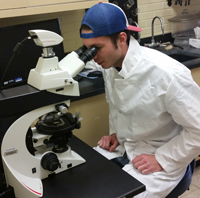 Student: Kevin Walsh
Student: Kevin Walsh
Class Standing: Senior, graduating May 2015, Accepted to graduate school
Kevin conducted high-pressure, high-temperature experiments to study how chlorine affects crystallization of Martian magmas. He has recently transitioned to investigating the potential for magnetite formation from oxidation and/or decompression of olivine.
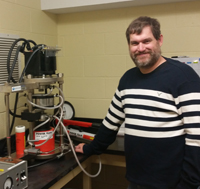 Student: Christopher McCoy
Student: Christopher McCoy
Class Standing: Graduated, 2014; Now in graduate school
Christopher experimentally investigated the origin of pink spinel in the lunar crust. He conducted high-pressure, high-temperature experiments to simulate crystallization of a lunar impact melt. He is now a graduate student here at SIUC working with Dr. Filiberto.
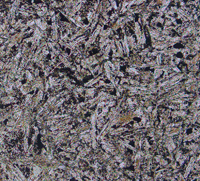
Student: Kelsey Manuel
Class Standing: Graduated, 2014
Kelsey conducted field work in the St. Francois Mountains and studied the mineralogy of the rocks to constrain their origin and crystallization.
To the left is one of the thin sections Kelsey studied; thin sections are thin slivers of rock that are examined under the microscope.
 Student: Joseph Krienert
Student: Joseph Krienert
Class Standing: Senior, graduating May 2015, Accepted to graduate school
Joe experimentally investigated the stability of amphibole in Martian magmas. He conducted high-pressure, high-temperature experiments to investigate the chemistry of amphiboles that could form from Martian magmas.
Potter-McIntyre Lab
Dr. Potter-McIntyre’s lab studies sedimentology, stratigraphy and the biogeochemistry of diagenesis with application to petroleum geology, Mars sedimentology and astrobiology. We investigate a range of research topics from porosity and permeability characterization of shales targeted for hydraulic fracturing to the paleogeography of both the Illinois Basin and the Colorado Plateau during the middle Jurassic and Cretaceous. Additionally, our research focuses on the diagenetic alteration of chemical, mineralogical and textural biosignatures throughout geologic time.
 Caleb Macer works in the lab of Dr. Potter-McIntyre using image processing software attached to a petrographic microscope to perform quantitative petrography on samples from the Jurassic Wanakah Formation on the Colorado Plateau. He is developing processing algorithms to differentiate minerals in photomicrographs of sedimentary rocks. His data will be compared with QEMSCAN data to determine accuracy.
Caleb Macer works in the lab of Dr. Potter-McIntyre using image processing software attached to a petrographic microscope to perform quantitative petrography on samples from the Jurassic Wanakah Formation on the Colorado Plateau. He is developing processing algorithms to differentiate minerals in photomicrographs of sedimentary rocks. His data will be compared with QEMSCAN data to determine accuracy.
Rimmer Lab
Dr. Rimmer is an organic petrologist and geochemist. Students working in her lab study coals, petroleum and gas source rocks, and a variety of black shales. These types of studies are very important to the coal and oil industries and the students gain experience that can give them a competitive advantage in the job market or in their application for graduate schools. Several of the projects in the past have contributed to presentations at professional meetings.
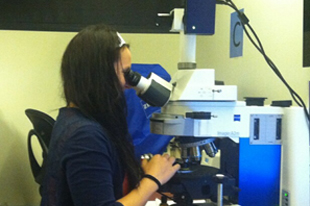 Amberly Tobin (B.S., 2013) worked as an undergraduate researcher on a project studying OHD (Oxidative Hydrothermal Dissolution), a novel technique for dissolving coal. She performed OHD runs, petrography of residues, and GC-MS analyses and later used her petrography experience during an internship at ConocoPhillips in Houston. She is currently a graduate student here at SIUC.
Amberly Tobin (B.S., 2013) worked as an undergraduate researcher on a project studying OHD (Oxidative Hydrothermal Dissolution), a novel technique for dissolving coal. She performed OHD runs, petrography of residues, and GC-MS analyses and later used her petrography experience during an internship at ConocoPhillips in Houston. She is currently a graduate student here at SIUC.
 Julie Driebergen (B.S. in progress) has been working on updates and new chapters for the web-based atlas on organic petrology, "Crelling's Petrographic Atlas of Coals and Carbons". This atlas has been used by researchers in acedemia and industry across the world as a source of information and images on coal and other organic matter. Julie is currently working on a chapter on thin-section photomicrographs.
Julie Driebergen (B.S. in progress) has been working on updates and new chapters for the web-based atlas on organic petrology, "Crelling's Petrographic Atlas of Coals and Carbons". This atlas has been used by researchers in acedemia and industry across the world as a source of information and images on coal and other organic matter. Julie is currently working on a chapter on thin-section photomicrographs.
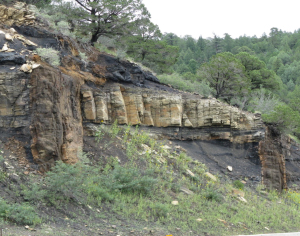 Catherine Dempsey (BS., anticipated May 2015) is working on the petrography and geochemistry of intruded coals in the Raton Basin of Colorado. Exposure to dikes and sills can severely alter the organic matter in coals and sediments; Catherine's work will help decipher the thermal history of shales and coals between and besides two dikes, at a location we call "Twin Dikes". She has recently been accepted to graduate school here at SIUC.
Catherine Dempsey (BS., anticipated May 2015) is working on the petrography and geochemistry of intruded coals in the Raton Basin of Colorado. Exposure to dikes and sills can severely alter the organic matter in coals and sediments; Catherine's work will help decipher the thermal history of shales and coals between and besides two dikes, at a location we call "Twin Dikes". She has recently been accepted to graduate school here at SIUC.
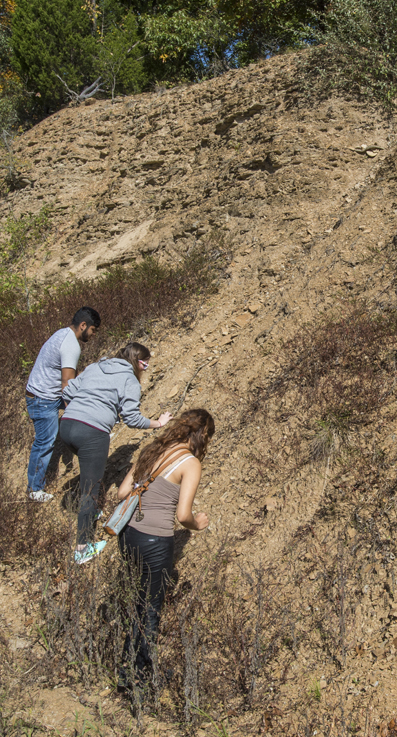




 Minka Bentley doing fieldwork along the Ohio River and collecting river water from across Southern Illinois for oxygen and hydrogen stable isotope analysis. This effort is part of a large project involving the International Atomic Energy Agency (IAEA) Global Network of Isotopes in Precipitation (GNIP) and Global Newtwork of Isotopes in Rivers (GNIR).
Minka Bentley doing fieldwork along the Ohio River and collecting river water from across Southern Illinois for oxygen and hydrogen stable isotope analysis. This effort is part of a large project involving the International Atomic Energy Agency (IAEA) Global Network of Isotopes in Precipitation (GNIP) and Global Newtwork of Isotopes in Rivers (GNIR). William Kipp in the field collecting samples for his project "Distribution of Rare Earth Elements (REE) in Fluorite".The field work was done in southern Illinois near the geologic structure known as Hicks Dome which could potentially be a future mineral source for REE. William is exploring the relationship between REE concentrations in fluorite and distance from Hick's Dome.
William Kipp in the field collecting samples for his project "Distribution of Rare Earth Elements (REE) in Fluorite".The field work was done in southern Illinois near the geologic structure known as Hicks Dome which could potentially be a future mineral source for REE. William is exploring the relationship between REE concentrations in fluorite and distance from Hick's Dome.




 Amberly Tobin (B.S., 2013) worked as an undergraduate researcher on a project studying OHD (Oxidative Hydrothermal Dissolution), a novel technique for dissolving coal. She performed OHD runs, petrography of residues, and GC-MS analyses and later used her petrography experience during an internship at ConocoPhillips in Houston. She is currently a graduate student here at SIUC.
Amberly Tobin (B.S., 2013) worked as an undergraduate researcher on a project studying OHD (Oxidative Hydrothermal Dissolution), a novel technique for dissolving coal. She performed OHD runs, petrography of residues, and GC-MS analyses and later used her petrography experience during an internship at ConocoPhillips in Houston. She is currently a graduate student here at SIUC.
